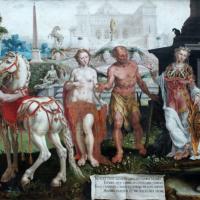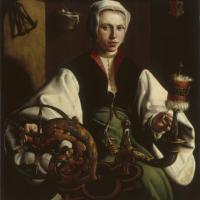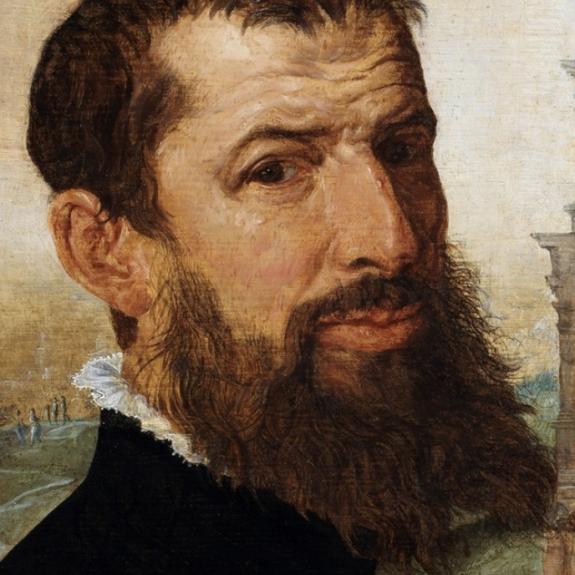Maerten Van Heemskerck
Maerten Van Heemskerck
Maerten Van Heemskerck (1498-1574)
Maerten van Heemskerck or Marten Jacobsz Heemskerk van Veen (1 June 1498 – 1 October 1574) was a Dutch portrait and religious painter, who spent most of his career in Haarlem. He was a pupil of Jan van Scorel, and adopted his teacher's Italian-influenced style. He spent the years 1532–6 in Italy. He produced many designs for engravers, and is especially known for his depictions of the Wonders of the World.
He was one of the first Netherlandish artists to make drawings specifically for reproduction by commercial printmakers. He employed a technique incorporating cross-hatching and stippling, intended to aid the engraver.
Heemskerck produced designs for a set of engravings, showing eight, rather than the usual seven wonders of the ancient world. His addition to the conventional list was the Colosseum in Rome, which, unlike the others, he showed in ruins, as it was in his own time, with the speculative addition of a giant statue of Jupiter in the centre. They were engraved by Philip Galle and published in 1572.
Many works by van Heemskerck survive. Adam and Eve and St. Luke painting the Likeness of the Virgin and Child in presence of a poet crowned with ivy leaves, and a parrot in a cage – an altar-piece in the gallery of Haarlem, and the Ecce Homo in the Museum of Fine Arts in Ghent, are characteristic works of the period preceding van Heemskerck's visit to Italy. An altar-pieceexecuted for the St. Laurence Church of Alkmaar in 1539–1543, composed of at least a dozen large panels, which including portraits of historical figures, preserved in Linköping Cathedral, Sweden since the Reformation, shows his style after his return from Italy.
He painted a crucifixion for the Riches Claires at Ghent (now in the Museum of Fine Arts, Ghent) in 1543, and an altar-piece for the Drapers' Company at Haarlem, finished in 1546 and now in the gallery of the Hague. They show how Heemskerck studied and repeated the forms which he had seen in the works of Michelangelo and Raphael at Rome, and in the frescoes of Andrea Mantegna and Giulio Romano in Lombardy, but he never forgot his Dutch origin or the models first presented to him by Scorel and Jan Mabuse.
As late as 1551 he produced a copy from Raphael's Madonna of Loreto (Frans Hals Museum). In 1552, he painted a view of a bull race inside the Colosseum of Rome (Palais des Beaux-Arts de Lille). A Judgment of Momus, dated 1561, in the Gemäldegalerie, Berlin, shows that he was well acquainted with anatomy and fond of florid architecture. Two altar-pieces which he finished for churches at Delft in 1551 and 1559, one complete (St. Luke painting the Virgin), the other a fragment, in the museum of Haarlem, a third of 1551 in the Brussels Museum, representing Golgotha, the Crucifixion, the Flight into Egypt, Christ on the Mount, and scenes from the lives of St. Bernard and St. Benedict, are all fairly representative of his style.
There is a Crucifixion in the Hermitage Museum of Saint Petersburg, and two Triumphs of Silenus in the gallery of Vienna. Other pieces of varying importance are in the galleries of Rotterdam, Munich, Cassel, Brunswick, Karlsruhe, Mainz, Copenhagen, Strasbourg and Rennes.
In his depiction of Saint Luke painting the Virgin, which Heemskerck painted twice for two painter's guilds, there is some confusion in the literature about a parrot. In both paintings he painted a parrot, but the parrot in a cage has been sawn off the first painting and is no longer visible.
In Amsterdam he made a will, which has been preserved. It shows that he had lived long enough and prosperously enough to make a fortune. At his death, he left money and land in trust to the orphanage of Haarlem, with interest to be paid yearly to any couple who should be willing to perform the marriage ceremony on the slab of his tomb in the cathedral of Haarlem. It was a superstition in Catholic Holland that a marriage so celebrated would secure the peace of the dead within the tomb.
Heemskerck was widely respected in his own lifetime and was a strong influence on the painters of Haarlem in particular. He is known (along with his teacher Jan van Scorel) for his introduction of Italian art to the Northern Netherlands, especially for his series on the wonders of the world, that were subsequently spread as prints. Karel van Mander devoted six pages to his biography in his Schilder-boeck.




